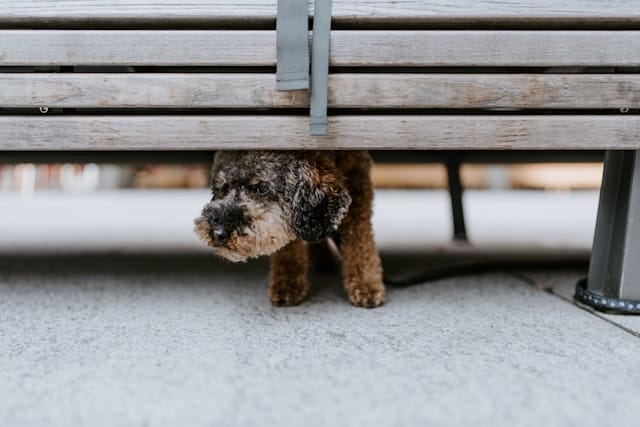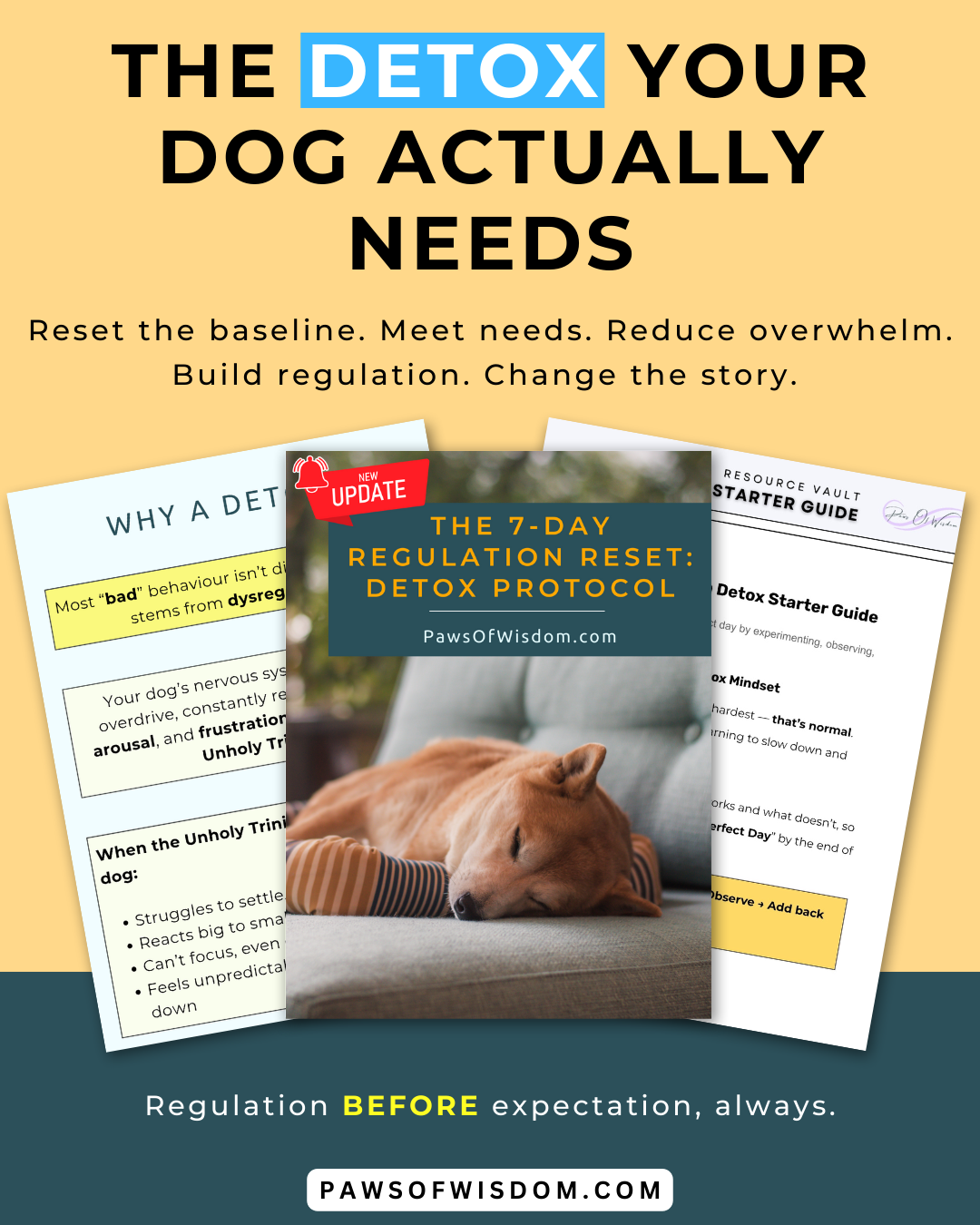Why Is My Dog Walking Slow With Head Down? 5 Common Reasons Explained
Your dog’s walking slower than usual. Their head’s unusually low. They’re not pulling, sniffing, or engaged...something seems off.
It might not seem like a big deal at first. Maybe they’re tired. Maybe they’re just “not in the mood”.
But when this becomes a pattern, it’s worth paying attention because a dog walking slowly with their head down may not just be taking their time...they could be showing signs of pain, emotional stress, anxiety, or even sensory shutdown.
Dogs communicate through body language, and when their normal pace changes, they’re telling us something important.
In this post, I’ll walk you through the five most common reasons behind this behaviour, how to spot the signs, and what you can do to help your dog feel safe, comfortable, and more engaged on their walks.

What That Slow, Head-Down Walk Might Actually Mean
A dog walking slow with their head down isn’t just a random behaviour. Firstly, the majority of dogs love walking, so a shift in behaviour is strange, but also, dogs communicate how they’re feeling through body language, and when their usual walking pace changes, it can mean they’re struggling with something.
Many owners assume their dog is just tired or being stubborn, but this slowdown can usually be linked to discomfort, stress, or disengagement. Ignoring these signs can lead to bigger issues, whether that’s underlying pain getting worse, chronic stress building up, or a lack of confidence making everyday walks feel overwhelming and diminishing resilience.
Once we figure out why your dog is walking this way, you can make the right adjustments; whether that’s a vet visit, a confidence boost, space to reset, or a simple change in routine to help them feel more comfortable, engaged, and happier on their walks.
Now, let’s break down five key reasons behind this behaviour…
At a Glance: Why Dogs Might Walk Slow With Their Head Down
Pain or discomfort
Fear, stress, or overstimulation
Boredom and disengagement
Emotional shutdown
Lack of clarity or boundaries
#1 - Pain: Rule This Out First
One of the most important things to consider when there is any sudden change of behaviour with your dog is pain. A sudden slowdown is often your dog’s way of saying something hurts.
Dogs are masters at hiding pain and discomfort, so even subtle changes in posture or movement can be one of the first telltale signs that something’s off.
If your dog suddenly slows down, lowers their head, or seems reluctant to walk, it’s crucial to firstly consider whether they’re in pain.
Common Causes Of Pain in Dogs:
Joint Issues: Conditions like arthritis, hip dysplasia, or general aging-related stiffness can make walking uncomfortable.
Muscle Strain or Injury: Overexertion, slipping, or rough play can lead to soreness that affects their walking.
Paw Problems: Cuts, burns from hot pavement, or something stuck in their paw (like a thorn) can cause discomfort.
Underlying Health Conditions: Neurological issues, infections, or internal discomfort could make movement painful.
What To Do:
Check their paws for cuts, burns, or anything stuck between their pads.
Observe their movement and check if they hesitate when getting up, seem stiff, or avoid certain motions.
Schedule a vet visit if you notice persistent changes in movement, discomfort, or any unusual behaviors.
Remember: Pain is the first thing to rule out. If discomfort is ignored, even simple activities can become stressful.
#2 - Fear & Stress: Is Your Dog Overwhelmed?
Not all slow walking is physical. Some dogs drag because they’re anxious, overstimulated, or unsure of their surroundings. If your dog is walking slow with head down, scanning their environment, or hesitating in certain areas, they might be experiencing fear, anxiety, or overarousal.
Some dogs become hyervigilant, processing every sound, movement, or scent, while others simply shut down when faced with too much pressure (sound familiar?)...
Signs To Look For:
Scanning or hypervigilance
Hesitating in certain areas
Slowing near other dogs, people, or noisy spots
Shutting down when pressure builds (classic trigger stacking)
Common Triggers That Cause Dogs to Slow Down on Walks:
Loud Noises – Sudden sounds like traffic, sirens, rubbish trucks, or fireworks can make some dogs feel uneasy.
Other Dogs or People – If your dog struggles with reactivity, they may slow down to assess or avoid a potential trigger.
Overcorrections – Leash jerks, scolding, or corrections can make a dog hesitant to walk freely, as they can lead to confusion or fear of making a mistake.
Overstimulation – Too much going on at once (fast-moving people, other animals, busy streets) can overwhelm dogs who struggle to filter out distractions.
If a dog experiences multiple stressors at once, this can lead to trigger stacking which is where small stresses build up until they become overwhelming. Along with being a common contributor to general stress or behaviour issues, this can also cause your dog to shut down, freeze, or want to avoid walking altogether.
What To Do:
Identify the stressors – Is your dog slowing down when approaching a specific area? Are they reacting to noises, people, or other dogs? Recognizing what makes them uneasy is the first step.
Lower expectations – If your dog is stressed, forcing them through the walk will only make things worse. Let them move at their own pace and avoid pushing them into overwhelming situations.
Use positive reinforcement – Reward small moments of confidence, whether it’s calmly walking past a trigger or choosing to disengage instead of shutting down.
Create clear communication - Reduce confusion in corrections by creating clear communication and boundaries of what you want and don't want.
🎯 Pro Tip: If stress keeps stacking, your dog may need a reset. My FREE 7 Day Detox Protocol helps dogs to decompress, lower arousal, and reset for calmer walks.
👉🏾 [Download It Here]
#3 - Boredom: Is Your Dog Disengaged?
Many owners assume that dogs naturally enjoy every walk, but for some, the same repetitive walk day after day lacks excitement.
While physical movement is important, dogs also need mental stimulation and outlets to stay fulfilled. When a walk lacks excitement or purpose, a dog may become disinterested, mentally checked out, and unmotivated, leading them to slow down, stop, or seem generally uninterested in the experience.
Signs Your Dog Is Bored on Walks:
Dragging their feet, looking uninterested, or stopping frequently
Sniffing excessively with no real focus (not engaging in scent work, just wandering)
Obsessive behaviour like trying to chase birds, frantic sniffing, pick up random objects, or fixating on movement
What To Do:
Change up the route – Try walking in new areas, even if it’s just taking a different street or reversing your usual route.
Make walks more interactive – Play "find it" with treats or you dogs food, encourage sniffing, or add in structured obedience and tug games.
Think beyond just walking – Many dogs benefit more from breed specific outlets like scent work, agility, or bitework than from a long walk.
🎯 Pro Tip: You can find out more about breed specific outlets and finding the perfect one for your dog in the Freebie Vault!
👉🏾 [Access It Here]
#4 - Emotional Shutdown: From Anxious to Checked Out
Dogs struggling with confidence often feel uncertain about their surroundings. They may be unsure how to handle new experiences, unfamiliar places, or interactions with people and other dogs.
Anxious dogs often appear hesitant, crouched slightly, or reluctant to move forward, especially in unfamiliar environments. Instead of engaging with their surroundings, they may keep their head low, tuck their tail, or pause frequently, signaling discomfort rather than disinterest.
Over time, that repeated stress can lead to anticipation based shutdowns or complete disengagement. Instead of pulling or reacting, they shrink. Walk with their head down. Avoid engagement. Try to get through it as quietly and quickly as possible.
Signs That Anxiety Is Slowing Your Dog Down:
Walking with their head low, ears back, or tail tucked.
Hesitating before moving forward or stopping frequently.
Avoiding eye contact or looking around nervously.
Seeming uninterested or flat.
Clinging to/hiding behind their owner or seeking reassurance throughout the walk.
What To Do:
Build confidence gradually – Introduce your dog to new environments slowly, pairing them with positive experiences.
Let your dog set the pace – Avoid forcing interactions or pushing them into situations and surroundings they’re not ready for.
Use plenty of encouragement – Celebrate small wins, like confidently stepping forward, investigating something strange or exploring without hesitation.
Change the expectation - The goal isn’t “complete the walk.” It’s “help my dog feel safe.”
Shorten the route - Quality > quantity. A 20 minute decompression activity may be better than a forced 1hour meltdown.
Reduce pressure - Ditch chaotic times, high-trigger routes, or rushed energy.
Help them reconnect - Bring in micro-asks (e.g. hand touches, “find it", pattern games, scatter feeding, or check-ins) paired with rewards to rebuild engagement gradually.

#5 – Lack of Clear Expectations or Boundaries
Sometimes the problem isn’t down to what’s happening on the walk, it’s what your dog’s supposed to do during it.
If your dog doesn’t understand what’s expected of them, they might default to hesitation, resistance, frustration, or avoidance purely out of confusion.
They don’t know where to walk. They don’t know what gets rewarded. They’re not sure what the plan is. And when everything feels vague or unpredictable, it can feel safer to slow down, check out, or stick to your side like Velcro.
Clarity and structure = confidence.
Not rigid obedience, but consistent cues, agreed boundaries and expections, and predictable routines.
Signs of unclear boundaries:
Your dog constantly looking to you for direction but not getting it
Hesitation or stopping in unpredictable places
Appearing nervous in familiar settings or routines
Easily distracted or overwhelmed by minor changes
Change of demeanor when a trigger is present
What To Do:
Establish a consistent routine — walk the same route while building clarity, then layer in novelty slowly
Use micro-skills — like "let’s go," "check-in," or a release cue to help your dog know what comes next
Avoid unfair corrections — clarity comes from guidance, not confusion or inconsistency
Celebrate moments of understanding — when they follow through on something with confidence, reward it like gold
Set and follow through with boundaries and expectations - start to shape the picture of how you want them to behave. Provide calm feedback, let them know what you want, and don't want.
This doesn’t mean walks need to be strict or robotic, you just have to add structure. It just means your dog feels safe knowing what’s happening and what their role is in it.
The Most Underrated Tool for Noticing What Matters...
If you notice your dog slowing, head down, or shutting off, don’t just try to remember it...log it. Patterns often reveal what’s helping and what isn’t.
The Digital Dog Training Journal + Progress Tracker helps you track:
Shifts in behaviour like slowing down, head carriage, or hesitation
What you tried that worked (or didn’t)
Energy levels, triggers, wins, and walk notes
Wins, setbacks, and patterns over time
Notes to share with your trainer, vet, or physio
And it all lives in one clean digital space — no paper clutter, no chaos, no forgetting.
👉🏾 [Grab The Journal Here] and start turning your observations into real, visible progress.
Final Thoughts
When your dog is walking slow with their head down, it’s easy to focus on the behaviour itself, but just like all problems we encounter when training dogs the real answers often sit beneath the surface.
Whether it’s pain, stress, anxiety, fear, boredom, or simply a walk that no longer meets their needs, the key is paying attention. Watching their body language.
Reading their energy. Tracking the shifts. And being willing to adjust based on what they’re showing you.
Whether that means the joys of a vet visit, reducing triggers, adding outlets to walks, or building confidence, small changes can make a big difference in how your dog experiences the world.
Sometimes, the solution isn’t more training (in most cases we are already doing the right training), it’s about stripping things back, meeting their core needs, and giving their nervous system space to reset.
Because when you start there, everything else starts to fall into place.
Frequently Asked Questions (FAQs): Why Is My Dog Walking Slow With Head Down
Sudden slow walking can be a sign that something isn’t right. Pain, joint issues, fear, stress, anxiety, or even emotional overwhelm could be at play. If you're mid-walk, check for pain (if your dog allows) and check your dog's environment. Always rule out health with your vet first.
A dog walking with their head down may be showing signs of discomfort, low mood, fear, or stress. Consistent low posture combined with slow movement can signal that something deeper is going on.
Yes — dogs that feel overwhelmed, anxious, or stressed often show it through their body language (they show everything through body language, we just don't listen). This might look like slow walking, head down, tension, or avoiding engagement. Reducing triggers, offering decompression, and meeting their needs can help ease this.
Signs of pain on walks might include slowing down, head lowering, limping, constant licking, stiffness, or resistance to move. Subtle signs like changes in posture, tail carriage, or unusual behaviour and personality can also be clues. Always check with your vet if you suspect pain.
If your dog looks disengaged or disinterested, it might be time to rethink your walking routine. Shorter, slower paced walks with plenty of sniffing time can help (allow time for this), alongside breed specific outlets and enrichment at home. Remember — quality matters more than quantity when it comes to walks. Save your bigger walks for the weekend when you have time.
Related Reading
A FREE community with downloadable guides and resources, and people who get it.
A simple and structured reset for overstimulated, dysregulated, chaotic dogs.
Simple, clear guidance to help you understand your dog through a regulation-first lens.












